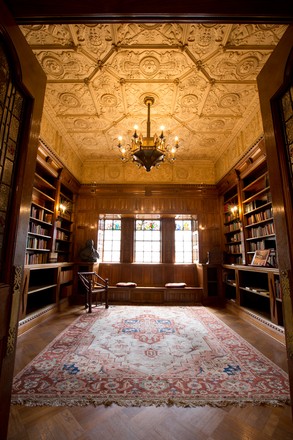
Shakespeare Room
completed 1942
Planning for the Shakespeare Room began in 1912, when members of the Shakespeare Society of NSW gathered to plan a commemoration of the 300th anniversary of Shakespeare’s death in April 1616. However, with the outbreak of World War I the event went almost unnoticed and it wasn’t until 1942 that this room finally opened to the public as the Shakespeare Tercentenary Memorial Library.
The design of the Shakespeare Room was inspired by the Tudor style of Cardinal Thomas Wolsey’s closet in Hampton Court Palace. The room is lined with Tasmanian blackwood and treated to resemble English oak. The motif of linen folds was a favourite among Tudor woodcarvers and is used throughout the panelling. Other exceptional examples of the woodcarver’s skill are the two intricately carved pillars just inside the door.
Above the door inside the room is Queen Elizabeth I’s coat of arms, which is repeated on the wooden cornice alternating with the coat of arms of the Earl of Southampton, who was one of Shakespeare’s patrons. Queen Elizabeth’s coat of arms bears her motto Semper eadem (‘Always the same’) and the inscription Honi soit qui mal y pense (‘Shamed be he who thinks evil of it’). Outside above the doorway and on the glass doors is Shakespeare’s own coat of arms, granted to his father John Shakespeare in October 1596. The motto Non sanz droict translates as ‘Not without right’.


 Back to list
Back to list